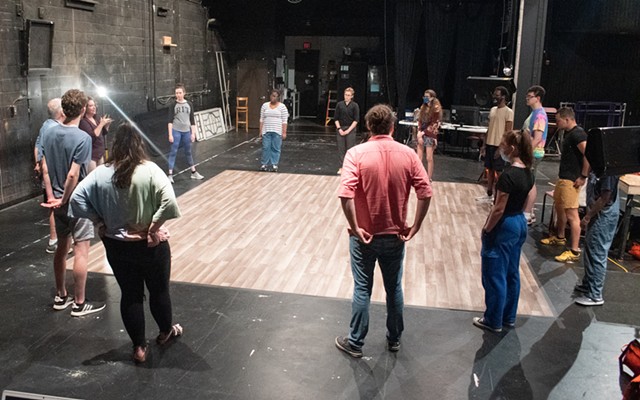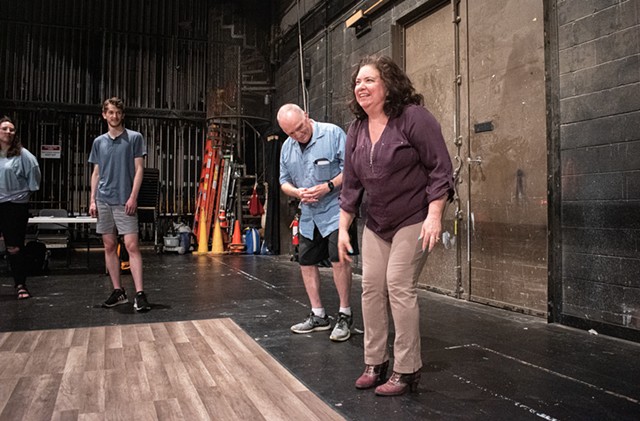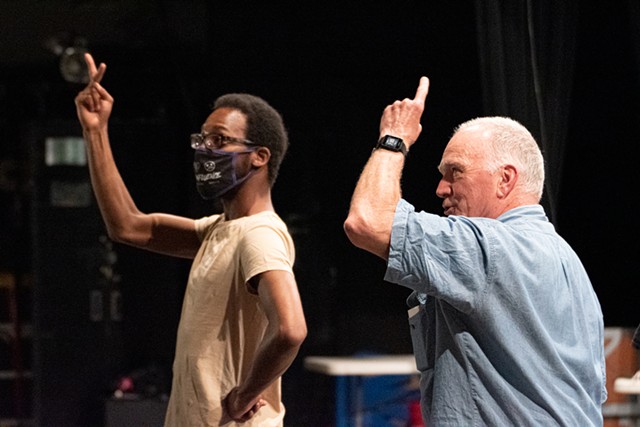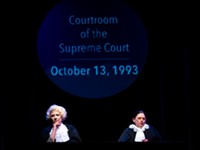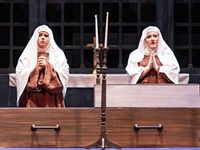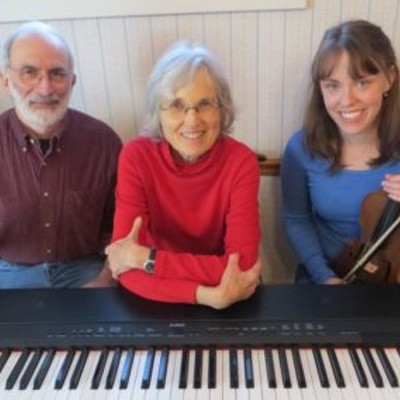A new production of 'The Tempest' in ASL and English goes beyond translation
By Katherine Varga @kvargs93[
{
"name": "500x250 Ad",
"insertPoint": "5",
"component": "15667920",
"parentWrapperClass": "",
"requiredCountToDisplay": "1"
}
]
A group of deaf and hearing actors stood in a circle onstage. Nobody spoke. Through eye contact and a shared sense of fun, they imagined their breath had condensed into an invisible ball, which they threw, kicked, and gently tossed around the circle.
A year ago, the thought of sharing breath would have been alarming rather than playful, but everyone in the cast was vaccinated. This warm-up started a rehearsal for the Rochester Community Players’ production of “The Tempest” — presented in both American Sign Language and English — which plays at the Highland Bowl on South Avenue from July 9 through 25 as this summer’s Shakespeare in the Park production.
“The Tempest” takes place on a deserted island, where Prospero and his daughter Miranda have been living with magical spirits for 12 years. Their quarantine ends when a shipwreck brings Prospero’s old enemies to shore.
While director Luane Davis Haggerty hopes spending time on this island will feel like a much needed vacation for audiences, she was largely drawn to the play for its magic, which allows her to explain the double reality of the dual-language production.
With a background as a playwright, actor, and theatre educator, Haggerty also has ample experience directing shows that bridge deaf and hearing actors, most recently with “Spoon River Anthology” at Rochester Institute of Technology’s National Technical Institute for the Deaf. Though a hearing person, Haggerty became fluent in ASL at a young age through growing up with a deaf grandmother. She teaches at NTID, which is offering “The Tempest” as a theater practicum for the summer session.
In Haggerty’s vision for the play, the deaf actors portray the characters as written by Shakespeare, only in ASL. The hearing actors play spirits from the island, who voice for them using Shakespeare’s English.
Unlike other productions that use deaf and hearing actors, such as Deaf West Theatre’s “Spring Awakening” — which was on Broadway in 2015 — the hearing actors play roles with separate personalities from the characters they’re voicing.
The spirits own the island, which sometimes gets inhabited by humans who get kicked out of Europe. “They’ve created a cultural ethic that when these flawed human beings arrive, they take care of them,” Haggerty says. “They follow them around, keep them out of trouble.”
This vision of the spirits is not in the original Shakespeare. As Haggerty says, depending on how one interprets the play, “you could really hate this play.” For this production, she’s “taken away the concept of colonialism” and changed the genders of some of the characters to include more women. “We can represent the world the way we’d like to see it,” she says.
Haggerty says the idea of spirits acting as a guardian angel for their character was taken from her observations as a director. “That’s what happens with the deaf actors,” she says. “They’ll adopt a hearing person and take care of them.”
Deaf people often feel isolated in a hearing world, Haggerty explains. When they find other deaf people who share their language, a strong sense of community is formed. This can extend to hearing people who sign or are willing to learn. Since several of the hearing actors are new to signing, student interpreters from RIT’s American Sign Language and Interpreting Education program attended rehearsals to aid in communication.
Tamara Chapman, who plays the signing Miranda, immediately bonded with the speaking Miranda, Eliza McDaniel, a senior in RIT’s ASLIE program.
“We had this connection,” says Chapman, as interpreted in English by McDaniel. “We can go back and forth together. We share a lot through our eye contact.”
McDaniel stops interpreting to excitedly sign and say, “I feel the same way! It’s wonderful to work with you. I’m like a little kid jumping up and down.”
Many cast members, including Chapman, are performing Shakespeare for the first time. Others are more experienced, including Malik Paris, who plays the signing Prospero. He has performed with New York Deaf Theatre in its production of “Titus Andronicus” and with The Public Theater’s “Twelfth Night” in New York City’s Central Park.
As Paris describes it, the two languages are separate but connected.
Before the first rehearsal, Haggerty “glossed” the entire play, meaning she used English words to write the signs that could be used to convey the meaning.
She says in some ways, interpreting Shakespeare was not as hard as one might expect, considering the archaic language. Some of the inverted sentences and word order that can make Shakespeare challenging to contemporary English speakers are actually fairly close to the word order in ASL grammar.
The gloss is intended to be a road map; as the show developed, the actors added their own body language, facial expressions, manner of presenting the signs, and physical acting choices.
The deaf actors also created sign names — which in deaf culture, is a way to represent a person without fingerspelling every letter in their name — for their characters. Traditionally, only a deaf person may assign someone a sign name.
This production opens with a promenade of each character introducing themself and presenting their sign name. Though this practice may look Elizabethan, it comes from the classical deaf theater tradition. It also gives the audience a chance to see which deaf and hearing actors are paired together.
Two actors walking next to each other is a rare luxury given the dangers of the pandemic. Many actors have found ways to perform this past year, such as over Zoom, but are grateful to be in a rehearsal room again.
“I’m used to that emotional connection you make with people standing next to you,” says Paris, as interpreted by McDaniel.
Alongside the joy of performing in person again, there’s still an adjustment period.
Although masks were not required in rehearsal because everyone was vaccinated, a few actors still wore masks as they navigated this transition into a production that, when it was first brought to Haggerty in February, was not guaranteed to be happening in person. Last summer’s Shakespeare in the Park production was canceled due to COVID.
“It feels weird to be normal,” says Sam Langshteyn, a Deaf RIT student studying film, who plays signing Ferdinand. “My social skills are dead.”
He says he has channeled those feelings into his character, whom he describes as being clueless when it comes to love. “I can play this guy who doesn’t know what the hell he’s doing,” he says.
Creating theater in a pandemic is strange and challenging — especially when it’s Shakespeare, in two different languages, all while relearning how to be in a room of people after a year of physical distancing.
But as Haggerty tells her actors worried about memorizing Shakespeare, “Onstage, you are never alone.”
“So suppose a line drops or you suddenly go blank,” she says. “Look at your partner — their blocking, how they’re standing, where they’re gesturing. You’ll remember.”
The Rochester Community Players' production of "The Tempest" is free and open to the public. For more information, go to rochestercommunityplayers.org.
Katherine Varga is a freelance writer for CITY. Feedback on this article can be directed to Daniel J. Kushner, CITY's arts editor, at [email protected].
A year ago, the thought of sharing breath would have been alarming rather than playful, but everyone in the cast was vaccinated. This warm-up started a rehearsal for the Rochester Community Players’ production of “The Tempest” — presented in both American Sign Language and English — which plays at the Highland Bowl on South Avenue from July 9 through 25 as this summer’s Shakespeare in the Park production.
“The Tempest” takes place on a deserted island, where Prospero and his daughter Miranda have been living with magical spirits for 12 years. Their quarantine ends when a shipwreck brings Prospero’s old enemies to shore.
While director Luane Davis Haggerty hopes spending time on this island will feel like a much needed vacation for audiences, she was largely drawn to the play for its magic, which allows her to explain the double reality of the dual-language production.
With a background as a playwright, actor, and theatre educator, Haggerty also has ample experience directing shows that bridge deaf and hearing actors, most recently with “Spoon River Anthology” at Rochester Institute of Technology’s National Technical Institute for the Deaf. Though a hearing person, Haggerty became fluent in ASL at a young age through growing up with a deaf grandmother. She teaches at NTID, which is offering “The Tempest” as a theater practicum for the summer session.
In Haggerty’s vision for the play, the deaf actors portray the characters as written by Shakespeare, only in ASL. The hearing actors play spirits from the island, who voice for them using Shakespeare’s English.
Unlike other productions that use deaf and hearing actors, such as Deaf West Theatre’s “Spring Awakening” — which was on Broadway in 2015 — the hearing actors play roles with separate personalities from the characters they’re voicing.
The spirits own the island, which sometimes gets inhabited by humans who get kicked out of Europe. “They’ve created a cultural ethic that when these flawed human beings arrive, they take care of them,” Haggerty says. “They follow them around, keep them out of trouble.”
This vision of the spirits is not in the original Shakespeare. As Haggerty says, depending on how one interprets the play, “you could really hate this play.” For this production, she’s “taken away the concept of colonialism” and changed the genders of some of the characters to include more women. “We can represent the world the way we’d like to see it,” she says.
Haggerty says the idea of spirits acting as a guardian angel for their character was taken from her observations as a director. “That’s what happens with the deaf actors,” she says. “They’ll adopt a hearing person and take care of them.”
Deaf people often feel isolated in a hearing world, Haggerty explains. When they find other deaf people who share their language, a strong sense of community is formed. This can extend to hearing people who sign or are willing to learn. Since several of the hearing actors are new to signing, student interpreters from RIT’s American Sign Language and Interpreting Education program attended rehearsals to aid in communication.
Tamara Chapman, who plays the signing Miranda, immediately bonded with the speaking Miranda, Eliza McDaniel, a senior in RIT’s ASLIE program.
“We had this connection,” says Chapman, as interpreted in English by McDaniel. “We can go back and forth together. We share a lot through our eye contact.”
McDaniel stops interpreting to excitedly sign and say, “I feel the same way! It’s wonderful to work with you. I’m like a little kid jumping up and down.”
Many cast members, including Chapman, are performing Shakespeare for the first time. Others are more experienced, including Malik Paris, who plays the signing Prospero. He has performed with New York Deaf Theatre in its production of “Titus Andronicus” and with The Public Theater’s “Twelfth Night” in New York City’s Central Park.
As Paris describes it, the two languages are separate but connected.
Before the first rehearsal, Haggerty “glossed” the entire play, meaning she used English words to write the signs that could be used to convey the meaning.
She says in some ways, interpreting Shakespeare was not as hard as one might expect, considering the archaic language. Some of the inverted sentences and word order that can make Shakespeare challenging to contemporary English speakers are actually fairly close to the word order in ASL grammar.
The gloss is intended to be a road map; as the show developed, the actors added their own body language, facial expressions, manner of presenting the signs, and physical acting choices.
The deaf actors also created sign names — which in deaf culture, is a way to represent a person without fingerspelling every letter in their name — for their characters. Traditionally, only a deaf person may assign someone a sign name.
This production opens with a promenade of each character introducing themself and presenting their sign name. Though this practice may look Elizabethan, it comes from the classical deaf theater tradition. It also gives the audience a chance to see which deaf and hearing actors are paired together.
Two actors walking next to each other is a rare luxury given the dangers of the pandemic. Many actors have found ways to perform this past year, such as over Zoom, but are grateful to be in a rehearsal room again.
“I’m used to that emotional connection you make with people standing next to you,” says Paris, as interpreted by McDaniel.
Alongside the joy of performing in person again, there’s still an adjustment period.
Although masks were not required in rehearsal because everyone was vaccinated, a few actors still wore masks as they navigated this transition into a production that, when it was first brought to Haggerty in February, was not guaranteed to be happening in person. Last summer’s Shakespeare in the Park production was canceled due to COVID.
“It feels weird to be normal,” says Sam Langshteyn, a Deaf RIT student studying film, who plays signing Ferdinand. “My social skills are dead.”
He says he has channeled those feelings into his character, whom he describes as being clueless when it comes to love. “I can play this guy who doesn’t know what the hell he’s doing,” he says.
Creating theater in a pandemic is strange and challenging — especially when it’s Shakespeare, in two different languages, all while relearning how to be in a room of people after a year of physical distancing.
But as Haggerty tells her actors worried about memorizing Shakespeare, “Onstage, you are never alone.”
“So suppose a line drops or you suddenly go blank,” she says. “Look at your partner — their blocking, how they’re standing, where they’re gesturing. You’ll remember.”
The Rochester Community Players' production of "The Tempest" is free and open to the public. For more information, go to rochestercommunityplayers.org.
Katherine Varga is a freelance writer for CITY. Feedback on this article can be directed to Daniel J. Kushner, CITY's arts editor, at [email protected].
Speaking of...
-

Rochester Community Players makes sense of the mess in ‘The Night Alive’
Mar 27, 2023 -

Calendar preview: A summer switcheroo
Jul 15, 2020 -

WallByrd flies the coop
Jan 11, 2017 - More »
Latest in Theater
More by Katherine Varga
-
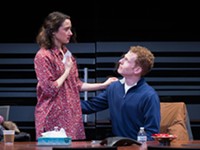
Theater Review | 'Newtown'
Apr 23, 2024 -
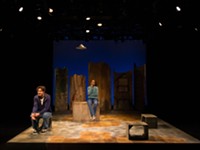
Theatre Review | 'Sanctuary City'
Apr 1, 2024 -
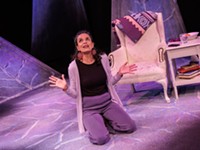
Theatre Review | 'Mala'
Mar 27, 2024 - More »
